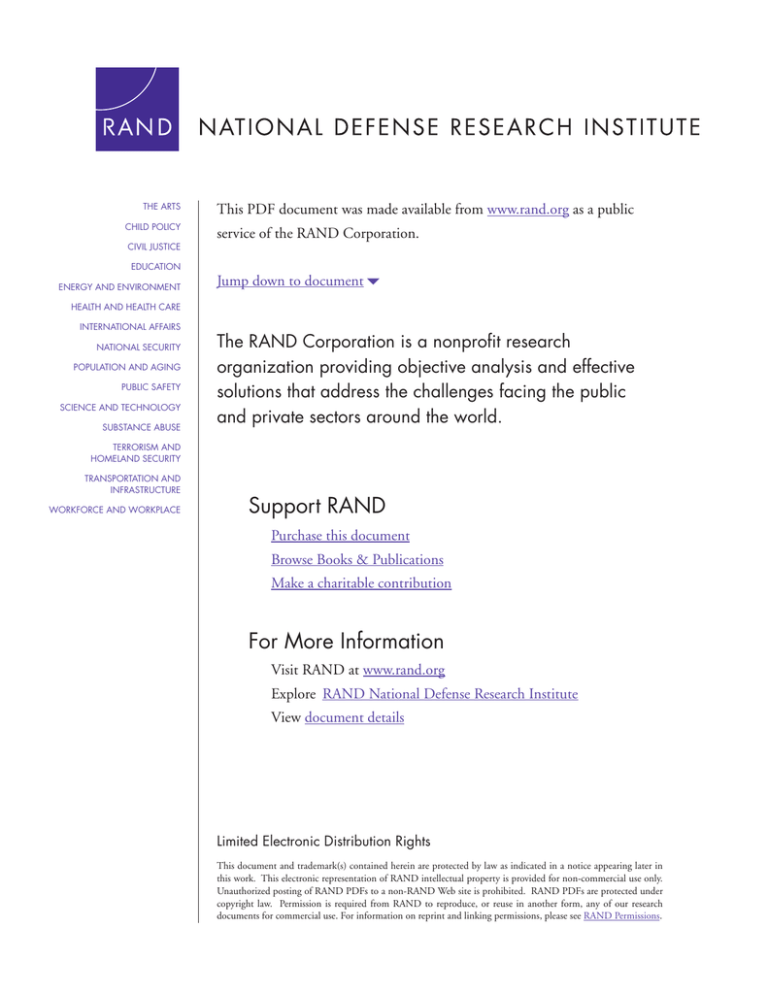
THE ARTS
CHILD POLICY
CIVIL JUSTICE
EDUCATION
ENERGY AND ENVIRONMENT
This PDF document was made available from www.rand.org as a public
service of the RAND Corporation.
Jump down to document6
HEALTH AND HEALTH CARE
INTERNATIONAL AFFAIRS
NATIONAL SECURITY
POPULATION AND AGING
PUBLIC SAFETY
SCIENCE AND TECHNOLOGY
SUBSTANCE ABUSE
The RAND Corporation is a nonprofit research
organization providing objective analysis and effective
solutions that address the challenges facing the public
and private sectors around the world.
TERRORISM AND
HOMELAND SECURITY
TRANSPORTATION AND
INFRASTRUCTURE
WORKFORCE AND WORKPLACE
Support RAND
Purchase this document
Browse Books & Publications
Make a charitable contribution
For More Information
Visit RAND at www.rand.org
Explore RAND National Defense Research Institute
View document details
Limited Electronic Distribution Rights
This document and trademark(s) contained herein are protected by law as indicated in a notice appearing later in
this work. This electronic representation of RAND intellectual property is provided for non-commercial use only.
Unauthorized posting of RAND PDFs to a non-RAND Web site is prohibited. RAND PDFs are protected under
copyright law. Permission is required from RAND to reproduce, or reuse in another form, any of our research
documents for commercial use. For information on reprint and linking permissions, please see RAND Permissions.
This product is part of the RAND Corporation occasional paper series. RAND
occasional papers may include an informed perspective on a timely policy issue, a
discussion of new research methodologies, essays, a paper presented at a conference, a
conference summary, or a summary of work in progress. All RAND occasional papers
undergo rigorous peer review to ensure that they meet high standards for research
quality and objectivity.
3 " / % $ 0 6 / 5 & 3 * / 4 6 3 ( & / $ : 4 5 6 %: t PA P E R 6
Doctrine of
Eternal Recurrence
The U.S. Military and
Counterinsurgency Doctrine,
1960–1970 and 2003–2006
Austin Long
Prepared for the Office of the Secretary of Defense
Approved for public release; distribution unlimited
NATIONAL DEFENSE R ESEA R C H I N ST I T U T E
The research described in this report was prepared for the Office of the Secretary of
Defense (OSD). The research was conducted in the RAND National Defense Research
Institute, a federally funded research and development center sponsored by the OSD, the
Joint Staff, the Unified Combatant Commands, the Department of the Navy, the Marine
Corps, the defense agencies, and the defense Intelligence Community under Contract
W74V8H-06-C-0002.
Library of Congress Cataloging-in-Publication Data
Long, Austin G.
Doctrine of eternal recurrence—the U.S. military and counterinsurgency doctrine, 1960–1970 and
2003–2006 / Austin Long.
p. cm. — (Rand counterinsurgency study ; Paper 6)
Includes bibliographical references.
ISBN 978-0-8330-4470-9 (pbk. : alk. paper)
1. Counterinsurgency—United States. 2. Military doctrine—United States. I. Title.
U241.L64 2008
355.02'18097309046—dc22
2008018294
The RAND Corporation is a nonprofit research organization providing objective analysis
and effective solutions that address the challenges facing the public and private sectors
around the world. RAND’s publications do not necessarily reflect the opinions of its
research clients and sponsors.
R® is a registered trademark.
© Copyright 2008 RAND Corporation
All rights reserved. No part of this book may be reproduced in any form by any electronic or
mechanical means (including photocopying, recording, or information storage and retrieval)
without permission in writing from RAND.
Published 2008 by the RAND Corporation
1776 Main Street, P.O. Box 2138, Santa Monica, CA 90407-2138
1200 South Hayes Street, Arlington, VA 22202-5050
4570 Fifth Avenue, Suite 600, Pittsburgh, PA 15213-2665
RAND URL: http://www.rand.org
To order RAND documents or to obtain additional information, contact
Distribution Services: Telephone: (310) 451-7002;
Fax: (310) 451-6915; Email: order@rand.org
Summary
The publication of a new COIN doctrine manual in late 2006 was widely heralded as an indication that the U.S. military was finally coming to understand the problems it has recently
faced in Iraq and Afghanistan. This interpretation assumes a tight linkage between doctrine
as written and operations conducted. As one way to test this proposition, this paper compares
modern COIN doctrine and operations with those of the 1960s.
In the 1960s, two periods of COIN doctrine can be observed. The first is 1960 to 1965,
the period after John Kennedy was elected President but before U.S. combat troops were
committed to Vietnam. The second is 1965 to 1970, the period of heaviest U.S. involvement
in the Vietnam War. In both cases, COIN doctrine as written by both the U.S. Army and
U.S. Marine Corps emphasized the role of the population (so-called hearts and minds), civilmilitary relations, small-unit operations, intelligence gathering, and related concepts. Yet operations seldom matched this written doctrine; instead, the military attempted to attrite the
insurgency through large-scale operations and heavy reliance on firepower. In short, doctrine
as written and operations conducted were not tightly linked.
As at least a partial explanation for this weak linkage, this paper posits a deeper set of
organizational concepts and beliefs that has a much greater influence on operations than written doctrine. While a set of beliefs can often be helpful to organizations in conducting their
preferred missions, it can be detrimental in other contexts. Much of the U.S. military prefers
high-intensity warfare, a mission for which the organization is mentally and materially well
prepared. However, mental preparation for this mission makes the military poorly suited to
COIN.
Altering the set of beliefs oriented toward high-intensity warfare will require more than
just new doctrine and some additional professional education. It will require significant reorientation of the services both mentally and materially. If correct, this paper casts doubt on the
military’s ability to truly be a “full-spectrum force,” because attempting to optimize for the
full spectrum of conflict may produce a force that is not particularly good at any one aspect of
that spectrum.
vii





